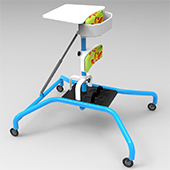Design Case study
Redesign of a Paediatric Standing Frame
Inexpensive standing frame for cerebral palsy children
by
Design process that was followed in this project:
• Introduction : All about Standing
- Why do Humans Stand Upright?
- How do Humans Stand Upright?
- The Human Balance System
- What is balance?
- Sensory input
- Input from the eyes
- Input from the muscles and joints
- Input from the vestibular system
- Integration of sensory input
- Processing of conPlicting sensory input
- Motor output
- Posture
• All about Standing frames
- Paediatric Stander
- Who uses Standing frame?
• All about Cerebral palsy
- What is Cerebral Palsy?
- Risk Factors
- About Muscle Tone
- Affected Areas of the Brain
- Types Of Cerebral Palsy
- Spastic
- Athetoid
- Dystonia
- Ataxic
- Mixed
- Choosing the correct stander
- Supine standers
- Prone standers
- Upright standers
- Standing and every day activities (function)
- What is the best angle for standing?
- How long should someone stand in order to gain these benefits?
- Benefits of using standing frames
- Doctors, Physiotherapists, orthopedicians, Professors, Paediatricians and Neurologists met for the project
- Discussions with Doctors, Physiotherapists, orthopedicians, Professors, Paediatricians and Neurologists
• Product study
- Existing products
- Expensive models
- Inexpensive Models
- The cheapest models
- Picking up from here
• Product examples
- Example 1
- Squiggles Stander
- Example 2
• Case Studies
- Case 1
- Case 2
- Case 3
- Indian Approach
• Ideations
- Concept 1
- Concept 2
- Concept 3
- Concept 4
- Concepts Validation
- Concept 5
- Short description of the product (elevator speech)
- Brief Description of the product
- Business canvas
- Value Proposition
• References
Case Study Download:
• Redesign of a Paediatric Standing Frame......
• Redesign of a Paediatric Standing Frame_Report......






















































































































